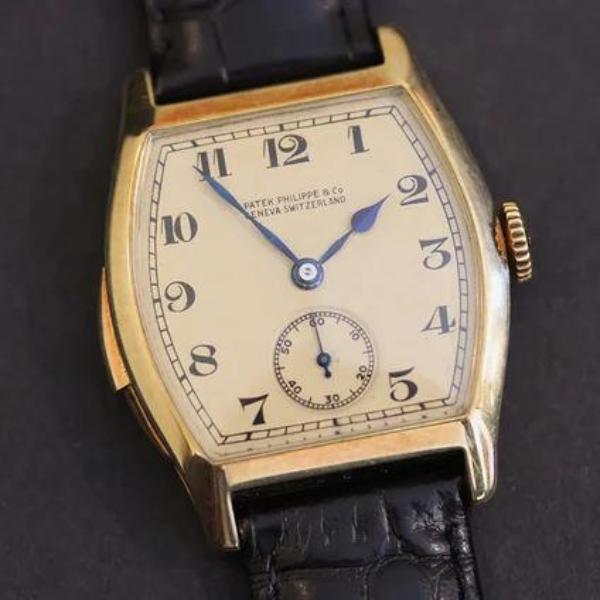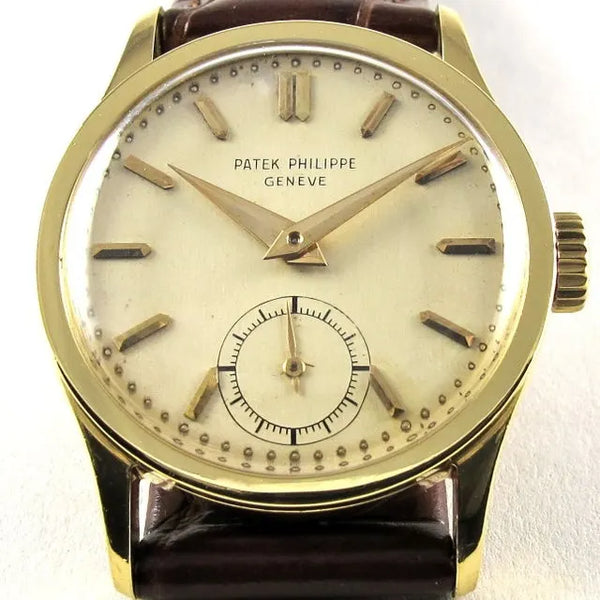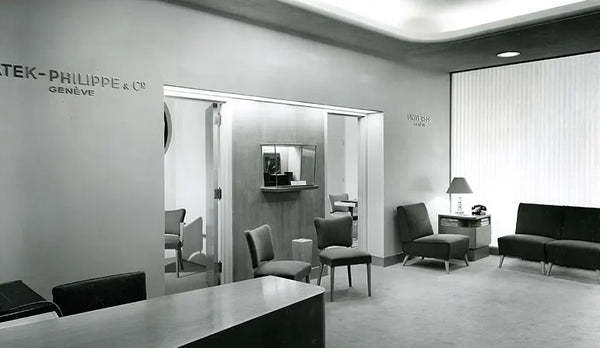
This week we continue our series honoring Patek Philippe’s 178th anniversary and the opening of their public Grand Exhibition: The Art of Watches (this July in New York City) with our third installment on the history of the world’s preeminent luxury watchmaking brand.
Schweizer Uhrenmesse, the Swiss Watch Show, which would later become universally known as “Baselworld”, was held for the first time in 1931. Patek Philippe showcased their collection, including the cushion-shaped minute repeater first unveiled in 1928. American financial titan Henry Graves Jr. received one of only three made in a tonneau-shaped case in 1929. While the timepiece competition between Graves and Packard would become legendary in the horological world, the global financial landscape was quickly diving into tumult. Worldwide repercussions of the Great Depression forced the company to seek a solvent buyer for a majority interest in Patek Philippe in the early 1930s.
 Photo Credit: watchonista.com
Photo Credit: watchonista.com
Charles and Jean Stern were brothers from a small town who had come to Geneva with their family and established a dial factory. Fabrique de Cadrans Stern Fréres had become a resounding success in the region and had enjoyed a close business relationship with Patek Philippe for many years. Following their hearts and striving to preserve a centerpiece of the Swiss watchmaking tradition, the brothers invested in Patek Philippe in 1932.
 Photo Credit: dreamchrono.com
Photo Credit: dreamchrono.com
The same year, Patek introduced the first model of the Calatrava collection. A timeless wristwatch which adhered to the Bauhaus principle – form dictates function – the Calatrava was understated, legible, and clear, elements which would make it a staple of Patek Philippe since its introduction.
The following year was highlighted by two grand accomplishments in the history of Patek Philippe. Completing a project first proposed by Henry Graves Jr. in 1925, Patek delivered the most complicated watch in the world in 1933. “The Graves” supercomplication pocket watch houses an astounding 24 complications in the double-faced gold housing which took five years to construct. The nine-hundred parts are a feat of engineering prowess that would make “The Graves” the most complicated watch on earth until it was replaced by another Patek piece in 1989. The Graves Supercomplication remains the most expensive watch in history, last sold in 2014 at auction in Geneva for over twenty-four million dollars (US).
 Photo Credit: sothebys.com
Photo Credit: sothebys.com
The delivery of the supercomplication was accompanied in 1933 by the hiring of Jean Pfister, head of the Tavannes Watch Co. in Geneva. His technical mastery in watchmaking led to the monumental decision to cease the purchase of movements from LeCoultre and begin production of all movement blanks internally at Patek Philippe. The company recovered financially and gained ground in the global marketplace under the new ownership. Charles Stern served as Chairman of the company beginning in 1935. His son Henri assisted him until 1937 when he was named head of Patek Philippe Incorporated of America. Following in the original spirit of Antoni Patek, Henri travelled extensively in the United States, building lasting relationships and expanding the Patek Philippe brand.
 Henri Stern, son of Charles Stern
Henri Stern, son of Charles Stern
The outbreak of global war in 1939 mandated a return to Switzerland for Henri, who served in a Swiss cavalry unit until his return to New York in 1940. Henri opened his own sales firm in New York in 1942. Beginning in 1946, the Henri Stern Watch Agency becomes the sole distributor of Patek Philippe watches for the United States. The period was not all joy however, Charles Stern died in 1944 and Jean Pfister resigned in 1946. Henri travelled between Geneva and New York extensively, as the global demands of the thriving business forced regular visits to both cities.
 Henri Stern Watch Agency, 1960
Henri Stern Watch Agency, 1960
Patek Philippe formed an Electronic Division in 1948. The division later embarked on the task of developing quartz movements as an alternative to mechanical movements. The famed Neuch?tel Observatory awarded Patek Philippe the series prize during their 1948 international timekeeping trials for the four best pocket and marine chronometers. The company launched their first self-winding model in 1953, enclosed in a water-resistant case.
Henri Stern became president of Patek Philippe in 1958. He proudly presented the world’s smallest quartz clock in 1960. Henri was impressed with the precision of electronic elements, marveling at the measurement of time to the thousandth of a second. The quartz clock introduced measured just 5” x 4” x 2.3” and caused a global sensation.
The availability of worldwide travel to the masses in the same period coincided with the introduction of the first watches with independently adjustable hour hands. Patek Philippe provided an option for the jet-set crowd who wanted to reset their watches to “local” time during their travels. The company introduced two configurations, with one hour hand or two, with the later allowing the wearer to never lose track of “home” time.
 Philippe Stern, son of Henri Stern
Philippe Stern, son of Henri Stern
Celebrating 125 years, Patek Philippe opened a new production facility on the bank of the Rhone in 1964. Two years later, Philippe Stern, son of Henri, joined the company. Founded in 1968, the Centre Electronique Horloger, is a joint venture of Swiss watchmakers to develop a quartz wristwatch caliber. After a year of research and development, the legendary Beta 21 Caliber is introduced at the Basel Fair on April 10, 1970.
Henri Stern remained at the helm of the company until 1977, when he turned Patek Philippe over to his son Philippe. Philippe Stern remained president of Patek Philippe until 2009, and under his control the company catapulted to the stratosphere of global watch brands.
Want to Learn More About the History of Patek Philippe?
Tune in next week for our final installment Part Four: Patek Philippe – Traditional Swiss Watchmaking Ascends to New Modern Heights and check out Part One: Patek Philippe – The Journey to Geneva and the Birth of a Legend and Part Two: Patek Philippe – The Evolution of Pocket Watches and Ownership
Also, join Shreve & Co. this July as we celebrate the Patek Philippe Grand Exhibition: The Art of Watches in New York City, New York. The event will present 27 timepieces on loan from the Patek Philippe Museum in Geneva, John F. Kennedy Presidential Library and Museum, and private collections. These exceptional timepieces will offer hands on insight into Patek Philippe’s most renowned U.S. patrons, and their passion for horology.


